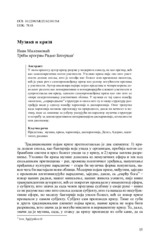Приказ основних података о документу
Музика и криза
Music and Crisis
| dc.contributor | Јовановић, Јелена | |
| dc.contributor | Медић, Ивана | |
| dc.creator | Миленковић, Иван | |
| dc.date.accessioned | 2018-09-07T09:41:24Z | |
| dc.date.available | 2018-09-07T09:41:24Z | |
| dc.date.issued | 2016 | |
| dc.identifier.issn | 1450-9814 (print) | |
| dc.identifier.issn | 2406-0976 (online) | |
| dc.identifier.uri | https://dais.sanu.ac.rs/123456789/3774 | |
| dc.description.abstract | У овом прилогу аутор кризу разуме у модерном смислу, не као претњу, већ као самопокретачки погон уметности. Утолико криза није оно што уметности долази споља, што је погађа као болест или временска непогода, већ је увек реч о самопроизвођењу кризе као услову могућности кретања у уметности. Аутор анализира најпре појам представе и четири корена довољног разлога као конзервативни и конзервирајући елемент уметности и супротставља им кризу, односно самопроизвођење кризе као оно што се опире склеротизовању уметничких облика. У музици се тај однос између окоштале, „оприродњенеˮ структуре и онога што ту и такву структуру разграђује види у односу између хармоније и дисхармоније. Оног тренутка када хармонија истакне претензију на природност, дакле на вечност и истину, пале се лампице за узбуну указујући на парализу музичке структуре и потребу за деконструктивном интервенцијом дисхармоније, атоналности или дисонанце. | sr |
| dc.description.abstract | In this article the author does not consider crisis a threat, but in a modern sense, an auto-motive drive of art. Therefore, crisis does not affect the art from the outside, it does not hit it as an illness or a storm, but it always produces itself, which is considered to be a condition for movement in art. First of all, the author analyzes the notion of representation and the four roots of the sufficient reason as a conservative and conserving element of art, to which he opposes crisis and its self-production as something that resists sclerotization of art forms. In music, the relation between the ossified, ˮnaturalizedˮ structure and that which decomposes that structure, manifests itself as the relation between harmony and disharmony. The moment when harmony shows a tendency towards naturality, understanding eternity and truth, an alarm is activated to show that music is being paralyzed and it needs a deconstructive intervention of disharmony, atonality and dissonance. | en |
| dc.language.iso | sr | sr |
| dc.publisher | Belgrade : Institute of Musicology, Serbian Academy of Sciences and Arts | sr |
| dc.rights | openAccess | sr |
| dc.rights.uri | https://creativecommons.org/licenses/by-nc-nd/4.0/ | |
| dc.source | Музикологија / Musicology | |
| dc.subject | представа | sr |
| dc.subject | музика | sr |
| dc.subject | криза | sr |
| dc.subject | хармонија | sr |
| dc.subject | дисхармонија | sr |
| dc.subject | Делез | sr |
| dc.subject | Адорно | sr |
| dc.subject | идентитет | sr |
| dc.subject | разлика | sr |
| dc.subject | music | sr |
| dc.subject | crisis | sr |
| dc.title | Музика и криза | sr |
| dc.title | Music and Crisis | en |
| dc.type | article | sr |
| dc.rights.license | BY-NC-ND | sr |
| dcterms.abstract | Milenković, Ivan; Мусиц анд Црисис; Мусиц анд Црисис; Muzika i kriza; | |
| dc.citation.spage | 15 | |
| dc.citation.epage | 26 | |
| dc.citation.volume | II | |
| dc.citation.issue | 21 | |
| dc.identifier.doi | 10.2298/MUZ1621015M | |
| dc.type.version | publishedVersion | sr |
| dc.identifier.fulltext | https://dais.sanu.ac.rs/bitstream/id/12012/bitstream_12012.pdf | |
| dc.identifier.rcub | https://hdl.handle.net/21.15107/rcub_dais_3774 |

